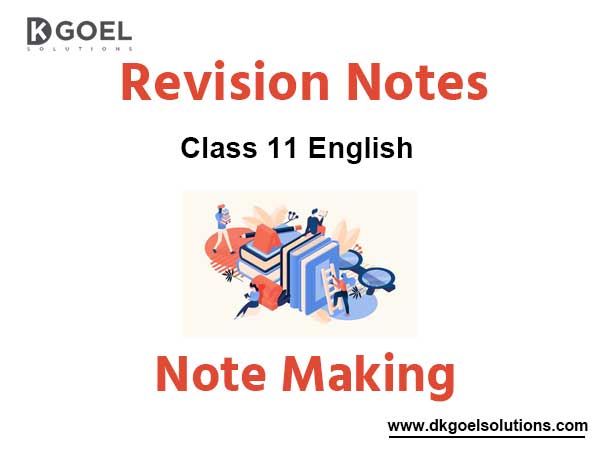Note Making Class 11 English
Get Note Making Class 11 Format PDF Download, which is based on the latest pattern of CBSE and NCERT. It involves every one of the points given in NCERT class 11 English book. You can easily download this Note Making Format Class 11 is given below.
Download Note Making Class 11 Format in PDF free of charge. It will help you to make your preparation better to score higher marks in exams. This Note making Class 11 Solved Examples is prepared by our expert teacher.
This Note Making Format Class 11 assists you with revising the complete chapter in minutes. One of the best tips suggested by teachers is revising the notes during exam time.
Characteristics of Notes
1. Short, no full sentences, only points
2. only the important mformabon included
3. logically presented in sequence
4. Organized aopropnaxery under Heading and Sub Heading.
Mechanics of Note-Making
1. Use of Abbreviations :
(a) Capitalized first letter of words: UNO. CBSE, NCERT etc.
(b) Arithmetic symbols: (><, ————–, kg, % etc.)
(c) Commonly used : (in newspapers, magazines etc.) : govt. etc., e.g.,
(d) Invented : First and last few letters of the world with a dot at the end (edun., poln., popn, Mfg.)
2. Proper indentation
Heading Title
(1) Main point…………..
1.1 Sub Point
1.2 Sub Point
1.3 Sub Point
1.3.1 Sub Sub Point
1.3.2 Sub Sub Point
3. Make use of words and phrases only. Avoid full length sentences.
4. Give Appropriate Title : The title may be given at the beginning. The notes are of 3 marks and should not be more than 1/3 of the passage’s length.
Marking Scheme / Pattern for Note Making and Summarising.
(a) Note-Title 1 Marks
(b) Abbreviation/Contraction 1 Marks (Minimum four)
(c) Sub-Headings (Four as per the requirement) along with 2-3 points 3 Marks
(d) Summary
Content 2 Marks
Expression 1 Marks
(Standard word UrrM lor summary is 80 words)
Note : Provide key for abbreviations used in your notes
Key to abbreviations
Problm = problem
Trpnt = transparent
Rqd = required
Dprsd = depressed.
Question: Read the following passage carefully and answer the questions that follow:
1. How does television affect our lives? It can be very helpful to people who carefully choose the shows that they watch Television can increase our knowledge of the outside world; there are high quality programmes that help us understand many fields of study, scienace, medicine, the arts and so on. Moreover, television benefits very old people who can’t often leave the house, as well as patients in hospital. It also offers non-native speakers the advantage of daily informal language practice. They can increase their vocabulary and practice listening.
2. On the other hand, there are several serious disadvantages to television. Of course, it provides us with a pleasant way to relax and spend our free time, but in some countries, people watch the ‘boob-tube’ for an average of six hours or more a day. Many children stare at a television screen for more hours each day than they do anything else, including studying and sleeping. It’s clear that the tube has a powerful influence on their lives and that its influence is often negative.
3. Recent studies show that after only thirty seconds of watching television, a person’s brain ‘relaxes’ the same way that it does just before the person falls asleep. Another effect of television on the human brain is that it seems to cause poor concentration. Children who view a lot of television can often concentrate on a subject for only fifteen to twenty minutes. They can pay attention only for the amount of time between commercials.
4. Another disadvantage is that television often causes people to become dissatisfied with their own lives. Real life does not seem as exciting to these people as the lives of actors on the screen To many people television becomes more real than reality and their own lives … boring. Also many people get upset or depressed when they can’t solve problems in real life as quickly as television actors seem to.
5. Before a child is fourteen years old, he or she views eleven thousand murders on the tube. He or she begins to believe that there is nothing strange about fights, killings and other kinds of violence. Many studies show that people become more violent after certain. Programmes they may even do the things that they saw in a violent show.
Ques 1. Make notes on the above passage using proper abbreviations (04) and suggest a suitable title.
Ans. (a) Title : The Impact of Television
Notes:
1. Benefits of T.V.
1.1 Inc. our know. Of o/s world
1.2 High qty prog
1.2.1 Fields – science, medicine, arts
1.3 Old people, patients – can’ t leave house
1.4 Non-native speakers – daily informal long. Prac.
1.5 Inc. vocabulary, listening
1.6 Way to Relax
2. Disadvantages of T.V./Boob-Tube on body
2.1 Long Duration of viewing – affects eyes
2.2 Human brain
2.2.1. gets drained
2.2.2. poor concentration
2.3 Effects of violent shows on adults/behaviour
3. Effects of T.V. on children
3.1. Lack of concentration in studies
3.2. gets used to violence
3.3. Loses discretion / understanding
4. Other effects
4.1 People become dissatisfied
4.2 Unable to diff. b/w reel and real life
4.3 Real life seems boring
4.4 Imitate actors
4.5 Get upset/depressed – unable to solve problems
Key to Abbreviations
1. Inc. – increases
2. o/s – outside
3. know – knowledge
4. lang. – language
5. prac. – practice
6. T.V. – television
7. difft. – differentiate
8. b/w – between
Ques 2. Write a summary of the above passage in about 80 words
Ans. Summary
The Impact of Television
Television viewing is both a boon and a bane. It’s an easily available source of entertainment for everyone, even old people and patients It offers high quality educational programmes. But it has a bad side too It drains our brain of energy and cauaea poor concentration in students. Violent shows often lead to violent behaviours in real life among children and adulta. People often get too attached with T.V. shows and actors tbmt they are unable to differentiate between reel und real life Thus. T.V. can be helpful to only those people who carefully choose the shows.
Question: Read the passage given below and answer the questions that follow.
In Delhi where 80% of the people are pedestrians in some stage of their commuting, least attention is paid in pedestrian paths. Delhi’s side walks are too narrow, very poorly maintained and full of potholes poles, junction boxes and dangerous electrical installation, not to speak of the garbage dumps that stink and stare at the pedestrian Ashram Chowk is a
good case in point where thousands of pedestrian change direction from the Mathura road radial to the Ring Road. A flyover facilitates the automobiles.
While the pedestrian is orphaned by the investment hungry authorities. One corner of the Ashram Chowk has a ridiculous imitation wood sculpture with an apology of a fountain and across the same Chowk you have the open mouthed massive garbage dump right on the pedestrain path in full exhibition for the benefit of the public. These symbols of poor taste and object apathy are then connected by narrow dangerous and often waterlogged footpaths for the helpless pedestrian to negotiate. In the night street lighting in the central median light up the carriageway for cars and leave the pedestrian areas in darkness.
Delhi’s citizens leave and want to get to their destination as fast they can. No one wants to linger on the road, no leisure walks, no one looks a stranger in the eye. It is on the pedestrian path that citizen encounters head on the poor public man agement and the excuse called multiplicity of authorities One agency makes the road, another digs it up to lay cables, third one comes after months to clear up the mess and the cycle of unaccountability goes on. Meanwhile crores are spent in reparing the carriageway for vehicles and in construction of the flyovers without a care for the pedestrian below. Solution offerd is to make an expensive underpass or an ugly foot overbridge, ostensibly for facilitating the pedestrian, while in reality they only facilitate the car to move faster at the expense of the pedestrian. Take Kashmiri gate, ITO, Ashram Chowk, AIIMS. or Dhaula Kuan, at all these important, at pedestrian crossover points the story is the same. They have pulled the sidewalk from the pedestrian’s feet.
In modern cities across the world, the pedestrian is king. The floor of the city is designed and maintained as an inclusive environment, helping the physically challenged, the old and the infirm children and the ordinary citizens to move joyful across the city, Delhi aspires to be world class city Hopefully the authorities would look once again at the floor of Delhi.
The pleasure of strolling on the road is deeply connected to our sense of citizenship and sense of belonging. Pride in the city gorws only on a well designed floor of the city.
Ques 1. On the basis of your reading of the abov epassage make-notes on it using heading and sub-heading. Also use recognized abbreviation wherever necessary (minimum 4) Supply a suitable title.
Ans. TITLE : ‘PEDESTRIAN IN DELHI’ Or ‘DELHI UNSAFE FOR PEDESTRIAN’
Notes :
1. Delhi : a major city for pedestrian
1.1 Poor maint. of sidewalks.
1.2 dangerous elect installation.
1.3 garbage dump.
1.4 Waterlogged footpaths.
2. Life in Delhi for citizens.
2.1 Fast life
2.2 Poor public manag.
2.3 Multiplicity of auth.
2.4 Unaccountability
2.5 Constly constructions but useless.
3. Pedestrian in the modern city.
3.1 Pedestrian; a king
3.2 Floor of the city to provide great help.
3.3 Facilities to the challenged old and the infirm child.
Key to Abbreviations
Maint – Maintainance
Elect – Electrical
Manag – Management
Auth – Authorities
Child – Children
Ques 2. Write the summary of the passage.
Ans. Summary
Delhi, although is a major city for the pedesatrians but provide least attention in the matter of facilities. The sidewalks are dangerous, narrow, poorly maintained, and full of potholes, garbage dumps, dangerous electrical fittings and stinky urinals. Public management is poor. Unaccountability can be seen on the part of authorities. Money is misused without providing care to the users. In the modern city. Where pedestrian is the king, the floor of city should he maintained by keeping in mind about the environment, physically challenged, old and infirm children. For making Delhi world class, the authorities would once again look at the floor of Delhi.

Students Who Practice this Note Making Class 11 Solved Examples will observe that each concept is depicted in a clear way including the equations, formula, diagram, important questions, and revision notes.
You can also download other study materials like Sample papers, MCQ Questions, NCERT Solutions, NCERT Book, Unseen Passage, and HOTs Questions for Class 11 English on our website.
We hope these notes will help you to score good marks in your exam. If you have any doubt in regard to Note Making Class 11 Format, write a comment in the box given below.

